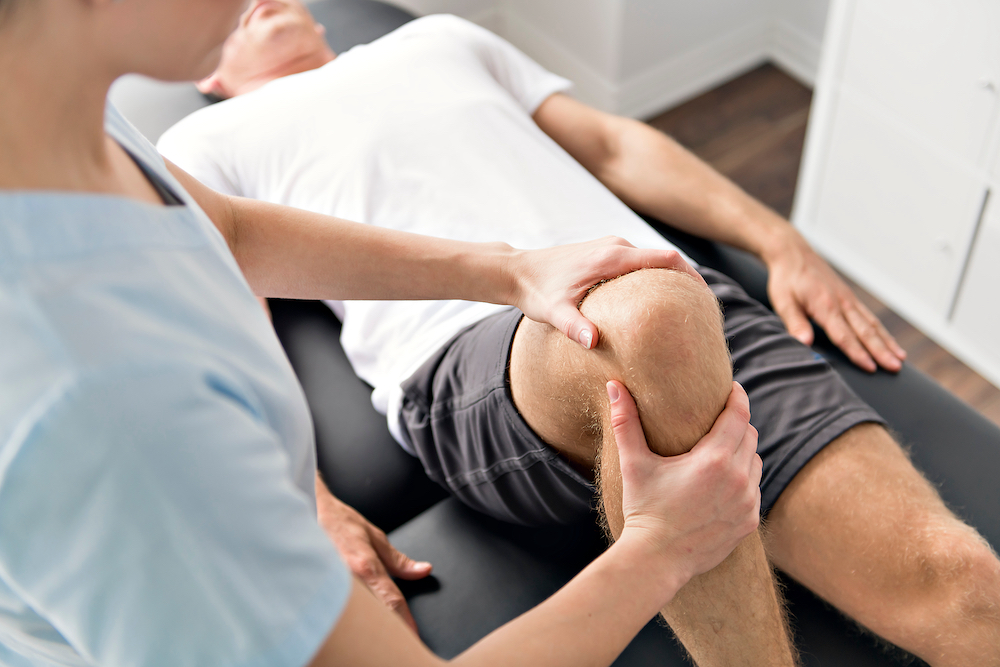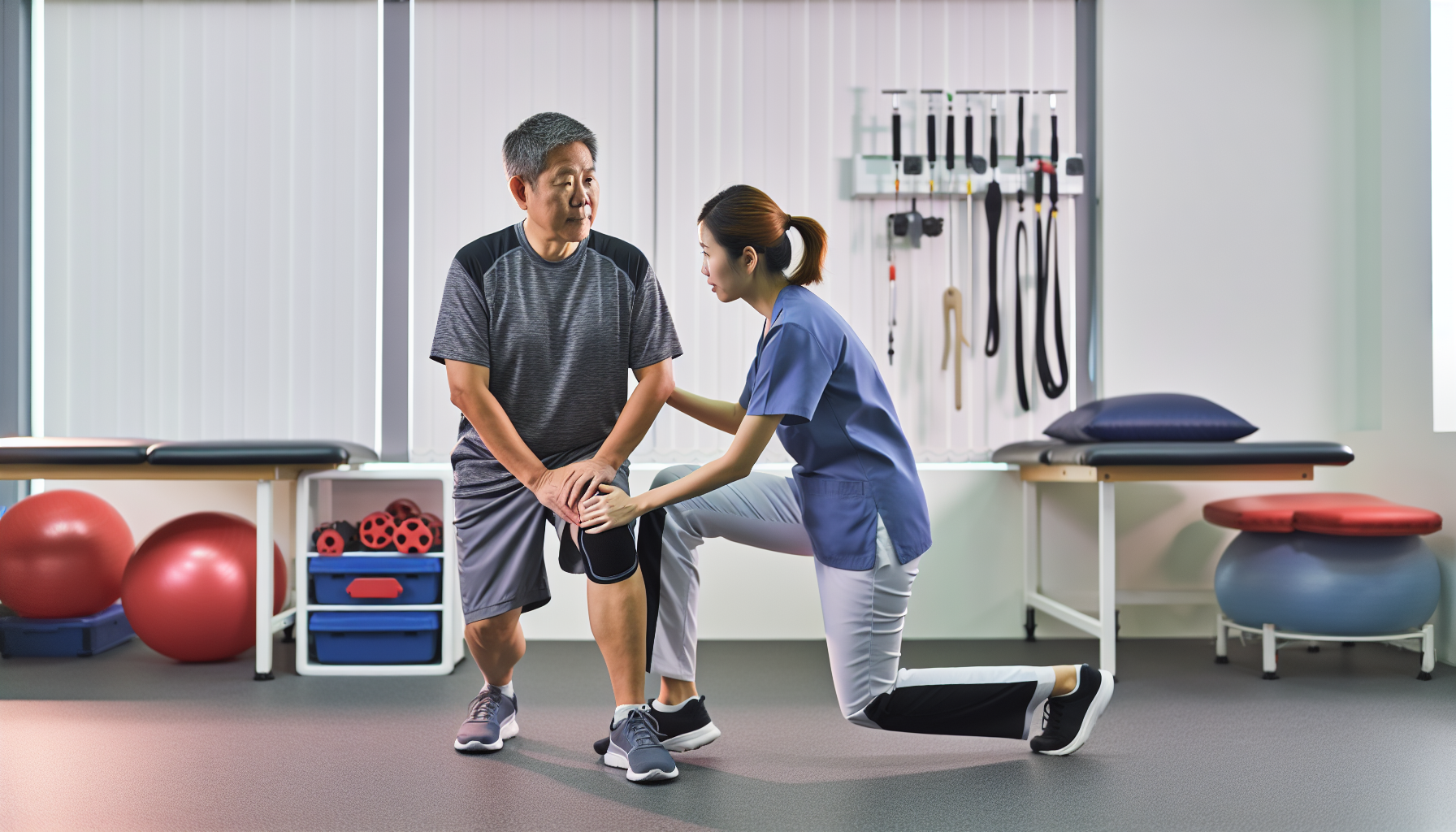Pain after knee replacement surgery is a typical part of the healing process. But what causes it, and how can you manage it effectively? This article directly addresses these pressing concerns with simple explanations and evidence-based pain relief strategies to foster smoother recovery for patients grappling with this common post-surgical issue.
Key Takeaways
- Effective post-surgery pain management in knee replacement is crucial for a quicker recovery process, involving medication, physical therapy, and alternative methods such as ice application and elevation.
- Postoperative knee pain can result from various causes including infection, implant issues, or nerve damage, and addressing these issues promptly is key to effective pain alleviation and optimal recovery.
- Maintaining a healthy weight, making home safety modifications, engaging in suitable activities, and having a support system are vital strategies for ensuring a smooth recovery from knee replacement surgery.
Pain Management After Knee Replacement Surgery

Successfully controlling pain after knee replacement surgery can accelerate the recovery process, including hastening physical therapy sessions, diminishing inflammation and promoting better healing. For superior pain control, strategies for managing discomfort might include a combination of medications such as opioids and non-steroidal anti-inflammatory drugs (NSAIDs), along with patient-administered analgesia pumps and nerve blocks. Although experiencing pain for several weeks post-replacement surgery is expected, proper management of this discomfort can enhance prospects for a more successful recovery.
Enhancing methods of pain relief following knee replacement procedures can contribute to reduced duration of hospital stays and decrease associated expenses while notably improving patient contentment and quality of life. Subsequent sections will delve into diverse tactics employed in addressing post-surgery pain starting from pharmaceutical interventions aimed at alleviating suffering.
Medications for Pain Relief
Following knee replacement surgery, it is common for individuals to be prescribed a range of medications such as NSAIDs, acetaminophen, and opioids to manage postoperative pain. Specifically, narcotic pain medications like morphine, hydromorphone, hydrocodone, oxycodone, and meperidine play a crucial role in immediate post-surgical pain relief. These drugs must be taken strictly according to medical advice and their use tapered off as the level of pain subsides.
Continuous supervision of patients’ respiratory functions and oxygen levels becomes necessary when they’re on opioid treatments due to the risk of respiratory depression associated with these drugs. Following proper dosage guidance for taking this medication can contribute significantly towards minimizing swelling, which facilitates physical therapy endeavors while also accelerating recovery following knee replacement surgeries.
To conventional medicines mentioned earlier, there are alternative options such as liposomal bupivacaine available. This drug can be administered directly to the site where surgery was performed, providing sustained relief from discomfort over approximately three days following the procedure. Patients might receive other types of medications including ondansetron or promethazine intended specifically for counteracting adverse reactions arising out either from anesthesia or narcotics employed during their comprehensive approach towards managing post-operative pains after undergoing Knee Replacement procedures.
Physical Therapy and Pain Reduction
Beginning just a few hours after knee replacement surgery, engaging in physical therapy plays an instrumental role in decreasing postoperative pain and aiding the recovery process. This is achieved through immediate mobilization and exercises designed to strengthen muscles. The rehabilitation plan structured by physical therapy focuses on enhancing flexibility, muscle building, and fulfilling objectives specific to each patient’s needs.
A comprehensive regimen of physical therapy after knee replacement encompasses activities starting from within the hospital setting to home-based routines as well as sessions with outpatient therapists. The key targets of this full-scale program include:
- Mitigating pain
- Improving mobility
- Restoring optimal functionality of the knee
- Professional guidance from a dedicated physical therapist
- Following a customized rehabilitation strategy
- Re-establishing movement capabilities
- Knee fortification
All these efforts are directed toward alleviating post-surgical discomfort via safe yet effective therapeutic exercises.
Alternative Pain Relief Methods
Alternative methods for alleviating postoperative knee pain can greatly enhance pain relief efforts following a knee replacement. The application of ice serves as an effective method to control pain after surgery, offering a significant reduction in discomfort both on its own and in combination with medications. It’s advised to apply ice packs no longer than 20 minutes at one time to help reduce swelling.
Incorporating leg elevation and ensuring sufficient rest are also vital components of an effective strategy for dealing with post-knee replacement surgery discomfort. Employing techniques like guided imagery, biofeedback, and cognitive-behavioral therapy could be beneficial in coping with pain experienced after undergoing knee replacement. Alternative approaches such as acupuncture have been known not only to alleviate knee-related pains but also to diminish swelling and promote enhancements in range of motion between the first week up until three weeks following the replacement procedure.
Potential Causes of Postoperative Pain
Understanding the underlying causes of postoperative pain is essential for its successful management and reduction. Persistent pain following total knee arthroplasty (TKA) has complex origins that include biological, surgical, and psychological factors.
Key contributors to postoperative discomfort may consist of:
- Levels of pre-surgery pain which can predict how intense the post-surgery pain might be
- The patient’s age since older individuals could face heightened levels of discomfort after surgery
- Mental states like anxiety and depression that have been known to amplify perceived pain during the recovery process
Gaining insight into these elements allows medical professionals to formulate appropriate strategies aimed at managing and mitigating pains particularly associated with postsurgical conditions.
Identified risk determinants for long-standing chronic agony following TKA include:
- Intensity of pre-procedure suffering
- Subpar mental health status
- A propensity towards magnifying one’s perception of painfulness
- Concurrent additional medical issues
Subsequent sections will explore in greater detail certain specific sources behind lingering pains after surgery such as infections, complications related directly to the implant itself, or injuries inflicted upon nerves.
Infection
Following knee replacement surgery, infections can trigger pain by the secretion of inflammatory molecules like IL-1. Common culprits include bacteria such as Staphylococcus aureus and Corynebacterium. Indicators that an infection may have set in are:
- Escalating pain with movement or at rest
- Altered appearance of the surgical site
- Experiencing chills
- Developing a high fever
It’s critical to obtain medical attention promptly if these symptoms emerge.
Not only do these infections cause discomfort, but they can also extend the duration of the recovery process after knee replacement surgery. Ensuring cleanliness and sterility during post-operative care is essential. Alerting your healthcare providers about any potential signs of infection is crucial for timely intervention, helping to avoid added complications and facilitating a smoother path to recovery from your knee replacement.
Implant Issues
Issues with the implant can lead to discomfort following a knee replacement surgery. Over time, surfaces of the implant may wear out and components might become loose, leading to pain. The loosening of the total knee arthroplasty implant is commonly linked to failure due to factors like instability, improper positioning of components, or bone loss caused by polyethylene wear.
Should patients notice that their knee feels unstable or seems to collapse unexpectedly after total knee replacement surgery, it could indicate a problem with the implant’s security. In such cases where there are undeniable indications for revision surgery because of these issues related directly to the prosthesis used in total knee arthroplasties (TKA), discussion on another operation becomes necessary. Revision procedures for persistent postoperative pain after TKA are complex. They entail removing existing prostheses potentially adding bone grafts and fitting specialized new implants. This route should be reserved when definitive causes tied specifically back to complications from initial replacement surgeries can be confirmed since results typically do not favor those undergoing revisions solely based on undiagnosed chronic pain reasons post-total joint replacement operations.
Nerve Damage
Nerve damage incurred during knee replacement surgery is another potential source of persistent postoperative pain, and it can manifest as ongoing severe discomfort, a loss of sensation, or muscle weakness in the limb that was operated on. For example, if the saphenous nerve’s infrapatellar branch is harmed during a knee replacement procedure, it could result in the development of an agonizing neuroma and adversely affect the function of the knee.
Persistent medial pain in the knee area specifically associated with an infrapatellar saphenous nerve neuroma may be evident when other explanations are ruled out. The routine incision made for total knee arthroplasty often cuts through this particular nerve branch which might then lead to forming a painful neuroma due to its entrapment within scar tissue following surgery. Although employed during operations to mitigate discomfort, nerve blocks may inadvertently impair muscular activity in the lower extremity. This presents a significant problem since actions such as walking and engaging in physical therapy are essential both for alleviating pain and facilitating recuperation after undergoing total knee replacement surgery.
Monitoring and Reporting Pain
Monitoring and communicating about post-surgical pain is an essential element of aftercare following a knee replacement. Utilizing a scale from 1 to 10, patients are expected to self-evaluate their discomfort levels, which serves as a critical tool for gauging the success of pain relief efforts following knee replacement surgery. To adequately address any issues with pain management, reassessments should be performed routinely.
It’s important that open communication is maintained with your surgeon and that you set realistic expectations for recuperation after undergoing a knee replacement procedure. Consider adopting these measures.
- Undergo thorough evaluations to fully grasp both the nature and severity of your post-operative pain.
- If persistent or unusual discomfort occurs outside the anticipated recovery timeframe, promptly discuss this with your healthcare provider.
- Adhere strictly to medical guidance provided by your surgeon concerning additional therapeutic options or amendments needed in your healing protocol.
Adhering closely to these recommendations will help facilitate more effective convalescence following knee replacement surgery and improve overall outcomes related to managing postsurgical pain.
Addressing Persistent Pain
Chronic knee pain, defined as discomfort lasting more than three months after a total knee arthroplasty (TKA), can significantly affect an individual’s quality of life-related to health. Around 20% of patients who undergo total knee replacement remain unsatisfied with the outcome, frequently due to persistent and severe knee pain.
In order to address continuous pain following TKA, several strategies may be employed. The premier approach for managing periprosthetic joint infection post-TKA is two-stage revision arthroplasty incorporating an antibiotic spacer along with thorough debridement and antibiotics selected according to the specific infection.
Complications from knee revision surgery are acknowledged concerns and include potential nerve or blood vessel damage as well as risks associated with blood clots. These issues can be effectively reduced by employing meticulous surgical techniques complemented by appropriate antibiotic use.
Tips for a Smooth Recovery
Achieving a successful recovery following knee replacement surgery requires careful planning and dedication to certain key practices, even before the surgical procedure. Ensuring that you keep your weight in check after a knee replacement is critical, as it helps reduce undue stress on the healing joint and diminishes the risk of causing injury or damage to the other knee.
Research indicates that within two years post-surgery, 66% of individuals who have undergone a knee replacement tend to gain approximately 15 pounds. This statistic underscores the importance of incorporating weight management strategies into one’s postoperative regimen. Here are several actionable suggestions for managing weight during this time.
- Embrace a nutritious diet filled with high-fiber items, proteins low in fat content, and carbohydrates with complex structures.
- Consume water before eating meals which can aid in achieving satiety sooner.
- Practice mindful consumption by eating at unhurried paces.
- Organize your meal preparation before undergoing surgery by creating healthy dishes ahead of time so they’re ready when needed during your convalescence.
Implementing these guidelines into your daily routine after having undergone replacement surgery for your knees can be instrumental in helping you retain an optimal body mass thus facilitating smoother progress through each phase of recuperation.
Home Modifications

Preparing your living space for a safe and manageable recovery is an essential part of the process before undergoing knee replacement surgery. To do this, you may:
- Clear out any clutter from your home to eliminate potential tripping hazards like loose rugs, stray furniture pieces, and electrical wires.
- If possible, add ramps in place of steps which can help simplify mobility around the house.
- Apply non-slip treatments to floors that tend to be slick to prevent falls.
Implementing these changes will help ensure a secure environment conducive for recuperation after your knee replacement.
It’s also advisable to set up a recovery area on the ground level of your home if available, as this circumvents the need for stair navigation post-surgery. Within this designated area, make sure that daily necessities such as eyewear, electronic gadgets along with their chargers, reading material, snacks, and drinks are easily reachable without straining yourself. Moreover, having grab bars by shower areas or toilets can significantly increase safety during bathroom use. Utilizing elevated toilet seats alongside having a seat while showering can Facilitate comfort and stability following knee replacement surgery.
Activity Recommendations
It is imperative to maintain an active lifestyle following knee replacement surgery. It’s just as vital to partake in activities that don’t overburden the freshly implanted knee. You can start driving again 4 to 6 weeks after undergoing replacement surgery once healing has sufficiently progressed and leg movement control has been re-established.
Initially, post-surgery mobility should involve using walkers or crutches, while avoiding stairs until a surgeon or physical therapist approves such activity. To stay active yet protect the new knee joint from unnecessary stress, participating in low-impact sports like swimming, cycling, and golf is advisable. Always seek advice from your surgeon before starting any exercise regimen or athletic endeavors after the surgery.
Support System
A strong and reliable network of support is essential for a smooth recovery following knee replacement surgery. During the recovery period from this surgery, patients often require assistance with various daily activities including:
- meal preparation
- running errands
- personal hygiene care
- managing laundry
This is due to their reduced ability to move around freely. Before the procedure, social workers or discharge planners can be instrumental in coordinating either at-home aid or arranging for a temporary stay in an extended care facility to ensure the patient’s needs are met.
Emotional support provided by friends, family members, and work associates plays an invaluable role both in deciding to undergo knee replacement and during the postoperative convalescence phase. Having a solid circle of emotional support contributes significantly to sustaining positive spirits and active participation needed for successful rehabilitation after such surgeries.
Long-Term Care and Maintenance
Securing a life devoid of pain after knee replacement surgery is not only about the success of the procedure itself but also hinges on ongoing care and safeguarding the endurance of the prosthetic joint to ensure smooth re-engagement with daily tasks. Keeping scheduled visits with your surgeon post-surgery is critical for tracking the status of your knee replacement as time progresses.
Around 80% remain free from needing any additional surgical intervention two decades following their initial knee replacements due to meticulous long-term upkeep. Much like automobile brake systems, high-impact activities can expedite deterioration in joint prostheses. Hence it’s crucial to participate in low-impact exercises while also managing body weight effectively. Undertaking timely surgery specifically aimed at liner substitution can circumvent more elaborate revision surgeries later on.
Summary
This manual has comprehensively addressed various aspects of managing discomfort following a knee replacement, including the employment of medication and physical therapy, adjustments to living spaces, and the necessity for robust support networks. It also investigated potential origins of pain after surgery such as infections, complications with the prosthetic joint, and nerve injuries while highlighting how vigilant monitoring and communication are key to effective pain control.
The task of controlling discomfort following a knee replacement can seem daunting. Equipped with appropriate techniques, resources, and encouragement, it is indeed feasible to navigate towards a fruitful recuperation reaping benefits from your new knee. Bear in mind that this pathway does not have to be traversed solitarily—assistance is abundant at your disposal. March forward on this journey toward an existence devoid of pain armed with confidence and positivity.
Frequently Asked Questions
How long does it take to walk normally after knee replacement?
Around six weeks following a knee replacement operation, the majority of people are able to ambulate independently without needing any walking aids. Recovery durations can differ.
Usually, the recuperation phase for a knee replacement surgery spans approximately 12 weeks.
What is the hardest part of knee replacement recovery?
During the initial six weeks following a knee replacement, patients often struggle with substantial pain and severe swelling, particularly in the first week, which is considered the most challenging period of recovery.
How do I get my knee to stop hurting after surgery?
To manage discomfort and facilitate the healing process after surgery, consider engaging in light walking exercises, using ice therapy at the site of your surgical incision, and adhering strictly to the prescribed pain medication regimen to mitigate knee pain.
What helps with pain at night after knee replacement?
To mitigate nighttime pain following a knee replacement, administer your medication approximately one hour before bedtime so that it becomes effective by the time you are ready to sleep. Apply ice to your knee just before going to bed and think about propping up your leg on a wedge pillow. This can enhance blood flow.
How long does the pain last after a knee replacement?
Typically, the discomfort experienced following knee replacement surgery subsides gradually over the first two to three weeks as part of the healing process.





 William D. Murrell, MD
William D. Murrell, MD Thomas B. Evely, DO
Thomas B. Evely, DO Clifford Voigt, MD
Clifford Voigt, MD Karthikeyan Chinnakkannu, MD
Karthikeyan Chinnakkannu, MD Max N. Seiter, MD
Max N. Seiter, MD Demetris Delos, MD
Demetris Delos, MD Lauren M. Fabian, MD
Lauren M. Fabian, MD